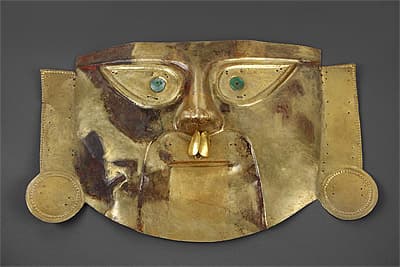
SICÁN-LAMBAYEQUE culture North coast 750 – 1375 AD
Mask 750-1375 AD gold, chrysocolla, cinnabar30.6 (h) x 49.7 (w) cm Museo Oro del Perú, Lima Photograph: Daniel Giannoni
Funerary masks made for the Sicán elite had many similar features: winged eyes, here inlaid with chrysocolla, a large nose and small mouth, large ears, and decorations such as nose-ornament pendants and large spool ear ornaments. The chysocolla iris is surmounted by a spherical bead for the pupil. The mask was painted with cinnabar (red mercuric sulphide), to represent its sacred function of supplying a face for the dead person in the afterlife. Unlike other jewellery, masks were not worn by the living in ceremonies, as they had no eye openings, but were sewn onto fardos, or mummy bundles, using holes pierced through the metal.
Masks were made of a single sheet and needed skilful annealing, that is, heating and cooling treatment to make the metal ductile and workable:
To evenly anneal such a large sheet probably required a special large brazier and several workers to charge it with charcoal and stoke it to maintain a high temperature. The sheet was hammered to a thickness that gave slight flexibility while maintaining overall structural rigidity.1
In Tomb I excavated at Huaca Loro at Batán Grande, a similar mask bore an extravagant crescent headdress with long golden plumes, made of extremely thin sheets of hammered gold. Judging by the depiction of the Lord of Sicán on many artefacts (see cats 107, 113, 117, 118, 124, 130–132, 134, 135), all such masks may have been crowned with ornate headdresses, painted in red, white and green, and embellished with precious stones for their interment.2
Christine Dixon
1. Izumi Shimada, Jo-Ann Griffin and Adon Gordus, ‘The technology, iconography and social significance of metals’, in Colin McEwan, Precolumbian gold: Technology, style and iconography, London: British Museum Press 2000, p. 47.
2. Rebecca R. Stone, Art of the Andes from Chavín to Inca, London: Thames and Hudson 1995, 3rd edn 2012, fig. 141, pp. 166–68.
Funerary masks made for the Sicán elite had many similar features: winged eyes, here inlaid with chrysocolla, a large nose and small mouth, large ears, and decorations such as nose-ornament pendants and large spool ear ornaments. The chysocolla iris is surmounted by a spherical bead for the pupil. The mask was painted with cinnabar (red mercuric sulphide), to represent its sacred function of supplying a face for the dead person in the afterlife. Unlike other jewellery, masks were not worn by the living in ceremonies, as they had no eye openings, but were sewn onto fardos, or mummy bundles, using holes pierced through the metal.
Masks were made of a single sheet and needed skilful annealing, that is, heating and cooling treatment to make the metal ductile and workable:
To evenly anneal such a large sheet probably required a special large brazier and several workers to charge it with charcoal and stoke it to maintain a high temperature. The sheet was hammered to a thickness that gave slight flexibility while maintaining overall structural rigidity.1
In Tomb I excavated at Huaca Loro at Batán Grande, a similar mask bore an extravagant crescent headdress with long golden plumes, made of extremely thin sheets of hammered gold. Judging by the depiction of the Lord of Sicán on many artefacts (see cats 107, 113, 117, 118, 124, 130–132, 134, 135), all such masks may have been crowned with ornate headdresses, painted in red, white and green, and embellished with precious stones for their interment.2
Christine Dixon
1. Izumi Shimada, Jo-Ann Griffin and Adon Gordus, ‘The technology, iconography and social significance of metals’, in Colin McEwan, Precolumbian gold: Technology, style and iconography, London: British Museum Press 2000, p. 47.
2. Rebecca R. Stone, Art of the Andes from Chavín to Inca, London: Thames and Hudson 1995, 3rd edn 2012, fig. 141, pp. 166–68.
Funerary masks made for the Sicán elite had many similar features: winged eyes, here inlaid with chrysocolla, a large nose and small mouth, large ears, and decorations such as nose-ornament pendants and large spool ear ornaments. The chysocolla iris is surmounted by a spherical bead for the pupil. The mask was painted with cinnabar (red mercuric sulphide), to represent its sacred function of supplying a face for the dead person in the afterlife. Unlike other jewellery, masks were not worn by the living in ceremonies, as they had no eye openings, but were sewn onto fardos, or mummy bundles, using holes pierced through the metal.
Masks were made of a single sheet and needed skilful annealing, that is, heating and cooling treatment to make the metal ductile and workable:
To evenly anneal such a large sheet probably required a special large brazier and several workers to charge it with charcoal and stoke it to maintain a high temperature. The sheet was hammered to a thickness that gave slight flexibility while maintaining overall structural rigidity.1
In Tomb I excavated at Huaca Loro at Batán Grande, a similar mask bore an extravagant crescent headdress with long golden plumes, made of extremely thin sheets of hammered gold. Judging by the depiction of the Lord of Sicán on many artefacts (see cats 107, 113, 117, 118, 124, 130–132, 134, 135), all such masks may have been crowned with ornate headdresses, painted in red, white and green, and embellished with precious stones for their interment.2
Christine Dixon
1. Izumi Shimada, Jo-Ann Griffin and Adon Gordus, ‘The technology, iconography and social significance of metals’, in Colin McEwan, Precolumbian gold: Technology, style and iconography, London: British Museum Press 2000, p. 47.
2. Rebecca R. Stone, Art of the Andes from Chavín to Inca, London: Thames and Hudson 1995, 3rd edn 2012, fig. 141, pp. 166–68.

